Cattle identification and traceability: consultation analysis
This report presents an analysis of responses received to the consultation on cattle identification and traceability in Scotland which ran from 4 April 2024 to 27 June 2024.
2. Consultation questions
Question 1: Do you support use of electronic ear tags as an official means of identification in cattle?
| Option | Total | Percentage |
|---|---|---|
| Yes | 193 | 90% |
| No | 21 | 10% |
| Total number of responses | 214 |

The overall number of responses to this question was 214. The majority of respondents responded ‘yes’ to this proposal. 90% of respondents supported the use of electronic ear tags as an official means of identification in cattle.
Reasons given for supporting this proposal included increased health and safety and improved data quality with the ability to store more information electronically. Respondents were also in favour of a more modern and simplified system that can be delivered by electronic means.
However, concerns were raised by all respondents regarding costs of both electronic tags and specific reading equipment. Some respondents suggested government funding to help with the increased costs.
5 respondents raised concerns over trade in Great Britain (GB) and the need for a GB-wide system to be introduced, in order to reduce potential trade barriers if there was not a uniformed approach across GB i.e. differing EID (UHF or LF) technologies.
4 respondents noted concerns about tag retention.
Question 2: Should ultra-high frequency (UHF) or low frequency (LF) technology be used?
| Option | Total | Percentage |
|---|---|---|
| UHF | 152 | 73% |
| LF | 25 | 12% |
| Not applicable | 32 | 15% |
| Total number of responses | 209 |

The overall number of responses to this question was 209. The majority of respondents (73%) were in favour of using UHF technology for electronic means of identification.
39 respondents specifically cited health and safety benefits of UHF technology. The greater reading distance of UHF was seen as a benefit as keepers do not need to be in as close proximity compared to when reading tags manually (or with LF readers with shorter read distance). This has been highlighted by some respondents as being especially useful when handling young calves and protective dams, which they have indicated may be dangerous for both the farmer and the calf.
9 respondents noted improved data quality, and 7 other respondents cited reading accuracy as their main reasons for choosing UHF as their preferred technology. The possibility to store management information electronically such as medical records and breeding information is attractive to cattle keepers. Some respondents noted that this would also reduce the administrative burden related to paperwork.
“We strongly believe that UHF technology should be used, the report from ScotEID in September last year underlined the multiple benefits and opportunities of UHF versus the now outdated low frequency alternative. Overall, offering a tool for the industry to have in the toolbox to improve business and livestock management. The direction of policy is to incentivise an efficient and forward-thinking beef industry, the progression of the mandate for UHF will enable farmers to meet the ambitious targets set by the Scottish Government.” [Organisation, The National Farmers Union Scotland]
The common themes emerging from other respondents (those that selected LF, not applicable or did not answer) indicated a preference for technology across the UK to be aligned or opted for LF technology on the basis that investment had already been made for existing sheep flocks.
“Whichever is most reliable and cost effective whilst allowing farmers to use existing scanners. Perhaps both are required.” [Individual]
11 respondents were unsure whether to choose LF or UHF technology and therefore, selected not applicable or did not answer the question. These respondents expressed that they did not have a strong opinion on technology choice and were either not sure of the difference or happy to support what would work best for farmers in practice. Some of these respondents felt this question was too technical and that they did not know enough about the technologies to make an informed decision.
5 respondents cited the lack of a current UHF reading standard for animal ID as their reason for choosing LF technology or not applicable. 6 respondents also expressed that they would opt for a dual LF/UHF technology tag if it were available.
Question 3: Do you support the use of any other forms of electronic identification as official means of identification (either as primary or secondary identification)?
| Option | Total | Percentage |
|---|---|---|
| Yes | 90 | 45% |
| No | 112 | 55% |
| Total number of responses | 202 |

The overall number of responses to this question was 202. Responses to this question were closely matched however, the majority of respondents did not support other forms of electronic identification.
Of the 90 people who responded ‘yes’, 11 suggested the use of a microchip, 5 suggested a bolus, 1 suggested a satellite and some other forms of non-electronic identification were also mentioned such as management tags (some of which are electronic) and freeze marking. 9 respondents supported the use of a combined technology for example, a UHF tag as a primary and LF tag as a secondary form of ID.
Many of the remaining respondents on both sides indicated that they were either unsure about the question or did not know enough about other forms of electronic identification and could therefore not comment further than a yes or no response. Some respondents suggested that it would have been helpful to have been provided with a list of alternative methods of electronic identification to be able to consider.
Respondents who responded ‘no’ indicated that they believed tags were the best form of electronic identification as the majority use this currently and other forms of electronic identification may be more costly than tags. Respondents also indicated that tags are preferrable due to the ID number being visible on the tag.
Question 4: Do you agree that there should be a legal requirement for new-born cattle to be identified with electronic ear tags?
| Option | Total | Percentage |
|---|---|---|
| Yes | 188 | 88% |
| No | 26 | 12% |
| Total number of responses | 214 |

The overall number of responses to this question was 214. 88% of respondents agreed that new-born cattle should be legally identified with electronic ear tags.
54 respondents who were in support of this proposal, indicated that it should be a legal requirement for new-borns to be identified with electronic ear tags within the same timeframe as is currently in practice.
6 respondents indicated that there should be more time allowed before tagging a calf, some citing calf mortality as a problem they have commonly observed during the early months.
2 respondents suggested that calves should be electronically tagged at the point of their first move off farm.
Question 5: If yes to Question 4, should current tagging exemptions remain, or should other categories of animals be exempted?
Common themes identified in response to question 5
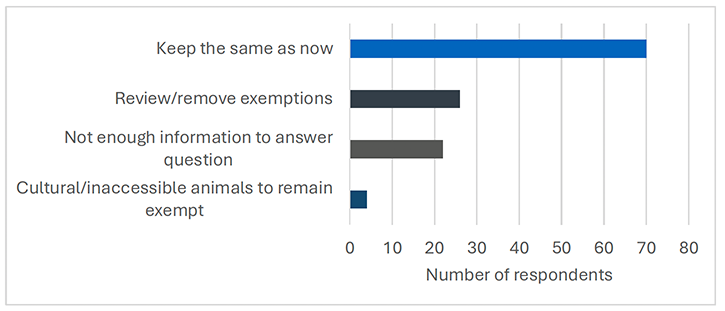
This question was an open question and provided a text box for respondents’ views. 70 respondents indicated that they support current tagging exemptions to remain as they are. Common reasons given to support this view were either, that the current exemptions are practical so they should stay the same, or that keepers are used to the current rules and too much change at once could cause confusion.
“All new-born cattle are required to be tagged within 20 days (for beef cattle) or within 36 hours (for dairy beef; a second ear tag must be fitted within 20 days from birth), Bison are currently the only exception to those timescales, with tagging either (i) allowed to take place up to 9 months from birth or (ii) before they leave the holding of birth or when they are separated from their mother. Because of the very small number of Bison in Scotland we suggest that the current exemption for Bison can remain, but we do not recommend adding tagging exemptions for any other categories of animals.” [Organisation, Centre of Expertise on Animal Disease Outbreaks]
26 respondents suggested that exemptions should be reviewed or removed.
“The Scottish SPCA believes that the current tagging exemptions should be reviewed to ensure they are still relevant and justified from an animal welfare perspective. While exemptions should be limited to maintain a robust traceability system, certain special cases, such as rare breeds, might well require continued exemptions. Each exemption should be evaluated on a case-by-case basis to ensure it aligns with welfare priorities across Scotland and the UK.” [Organisation, SSPCA]
22 of the respondents did not feel they had enough information on current exemptions to be able to comment on this question.
4 respondents expressed that current cultural exemptions or inaccessible animals should remain exempt.
Question 6: Do you think that there should be a requirement to identify animals in the ‘historical herd’ (animals which are alive and are already identified) if and when EID is introduced?
| Option | Total | Percentage |
|---|---|---|
| Yes | 115 | 53% |
| No | 100 | 47% |
| Total number of responses | 215 |

215 responses to this question were received. 53% of respondents were in favour of identifying animals in the historic herd using EID if introduced. There was a variety of themes on both sides emerging from the analysis of this question which are set out in the graph below.
Common themes identified in response to question 6
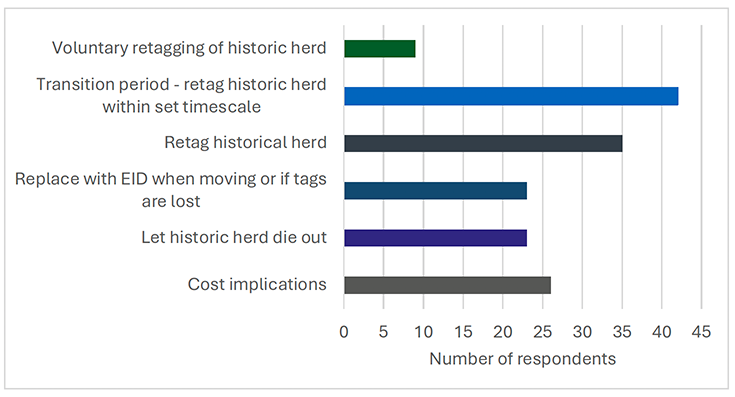
42 respondents that were in favour of re-identifying the historical herd, suggested a transitional approach. 35 respondents in favour of re-identifying the historical herd, highlighted that if this wasn’t done, it would be necessary to run 2 systems until the herd all died out.
“The quicker all cattle are on the system the better. Especially in suckler cows where breeding cows could be in the herd for 15 years. The quicker all cattle are identified in the same way the quicker all producers/markets/processors will be become more efficient and we can get rid of the outdated paperwork.” [Individual]
23 respondents were in favour of event-driven approaches to re-identify the historic herd, including replacing lost tags with EID or retagging animals when moving off from the holding. 23 respondents highlighted that if EID were to be brought in over a transition period of 2-5 years, then it is likely that a large proportion of the historic herd would die out naturally or through slaughter. Thereafter, only a small proportion of older cattle would remain, and consideration would be needed on how best to electronically identify the remaining historic herd.
26 respondents highlighted cost as an issue and a reason to have a reasonable transition period in advance, so that only a small proportion of the historic herd would require to be retagged. Money would therefore not be spent unnecessarily, and retagging could be kept to a minimum.
Another proportion of respondents (9 participants) suggested that re-identifying the historic herd with EID could be a voluntary option and would be up to the individual keeper’s discretion.
Respondents not in favour of re-identifying the historic herd mostly referenced cost as an issue, suggesting that retagging should be voluntary unless funding is provided by government. Some respondents also felt that it would be an unnecessarily risky process to accomplish, as tagging cattle can be dangerous. Furthermore, many cattle, especially beef cattle, have a life span which would exceed a transitionary period of 2-5 years.
“Keepers should be able to voluntarily 'upgrade' cattle to EID or may be obliged to do so if a primary tag is lost. If cattle EID is as helpful to farmers as is suggested, the industry will voluntarily take up EID in the historical herd without coercion.
The tag retention rate in Scotland is such that the vast majority of cows would be upgraded via this mechanism within 4 years, which would be infinitely more palatable to the industry than an obligation to upgrade cattle at the outset.
This is the only event driven compulsory upgrade which is acceptable. If there were to be an obligation on farmers to EID tag cattle before leaving the holding, they would have to meet the cost of this (both the tag and the handling) whilst deriving no tangible benefit.
As is the case with a huge proportion of Scotland's lambs, many tags would read only once at the point of slaughter. The tag is of no benefit to the farmer when used in this way, and we should not create the same situation for cattle.” [Individual]
Question 7: If so, should there be a requirement to apply EID to all animals in the historical herd by a certain date or should the need to use EID be ‘event driven’?
Common themes identified in response to question 7
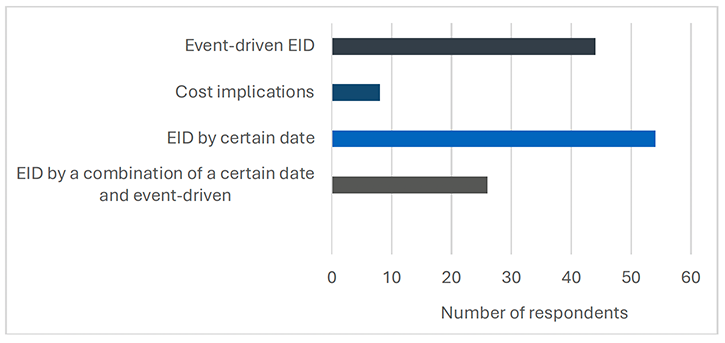
This was an open question with a text box for comments, common themes were identified from the responses. 54 respondents were in favour of applying EID to all animals in the historic herd by a certain date. 44 respondents were in favour of introduction of EID to the historical herd being event-driven, and 26 respondents opted for a combination of the two. 8 respondents cited cost as a barrier and suggested support schemes or funding to help if animals are to be re-identified.
Many of these respondents suggested an approach where any conventional ear tags that have been lost could be replaced with EID tags and when an animal is leaving the holding, then an EID ear tag could also be applied at this point. This would mean that many of the historic herd would gradually have their tags replaced and respondents suggest that a transitionary period up until a certain final date could be introduced for the rest of the herd who had not moved or had replacement tags.
“The Scottish SPCA recommends setting a deadline for applying EID to all animals in the historical herd ensures a timely and systematic update of the identification system. However, allowing for event-driven tagging (e.g., during veterinary visits, sales, or movements) can facilitate the transition and reduce stress on the animals, which is our primary concern, and also allows for spreading the process over time.” [Organisation, SSPCA]
A period of 3-5 years using this approach was suggested by many respondents as the majority of animals would be re-identified through events described above or would have passed into the food chain within that timeframe.
Question 8: What are your views on introduction of an online holding register?
Common themes identified in response to question 8
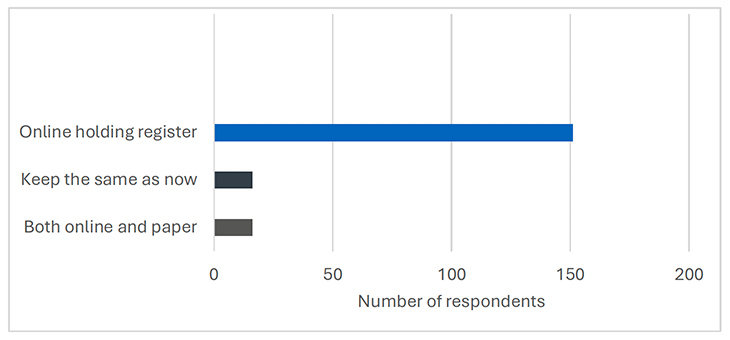
This was an open question with a text box for comments. 151 respondents were in favour of an online holding register. 16 respondents opted to keep the current paper system, and another 16 respondents were in favour of having the option of both an online and a paper holding register. The ScotEID system already acts as a ‘partial’ online holding register for within business moves (internal movements within a business). The remaining respondents either did not answer this question or it was not possible to identify a common theme when analysing the responses.
Overall, most respondents support the introduction of an online holding register but this is caveated that the system must be simple and easy to use and that there is adequate training for keepers who are not used to using computers and/or online software. It was also highlighted that more remote areas may need more consideration as there can be poor internet connectivity and less technology in use, for example, within the crofting community.
“While this makes sense, some people will face barriers in accessing/using the relevant technology and hence may want to keep their holding register in paper form. This should not cause any issues when all the details are already on ScotEID available to all the regulatory bodies that require them.” [Organisation, The Scottish Crofting Federation]
Question 9: Should reporting timescales for births, movements and deaths for holding registers and the central database be aligned?
| Option | Total | Percentage |
|---|---|---|
| Yes | 146 | 71% |
| No | 61 | 29% |
| Total number of responses | 207 |

The overall number of responses to this question was 207. A majority of 71% of respondents were in favour of reporting timescales to be aligned if a new online holding register was introduced. 29% did not agree that reporting timescales for births, movements and deaths should be aligned for holding registers and the central database.
Any comments and further analysis of this question are covered under the next question which had a text box for responses. This question had only ‘yes’ or ‘no’ as an option.
Question 10: If yes, what should they be? Please give us your views.
This question was an open question with a text box for answers. Responses were varied in nature and common themes were difficult to identify so only the two most common themes have been shown below.
Common themes identified in response to question 10

The current reporting deadlines are: 27 days to register a birth, 7 days to report a death and 3 days to report movements. The majority of respondents (58 of those who answered) were in favour of keeping current reporting timescales.
The second largest proportion of respondents (17 participants) suggested various timescales ranging within 3-5 days. Most of this group did not specify whether the timescales suggested related to movements, deaths or births.
Other respondents that provided an answer to this question suggested that timescales should be extended, however, as mentioned, many did not specify whether the timescale they have suggested was for births, deaths or movements.
The remainder of participants either did not provide an answer to this question or a common theme could not be identified.
Question 11: What are your views on the removal of paper passports?
Question 11 was also an open question, with a text box for respondents to give their views.
Common themes identified in response to question 11
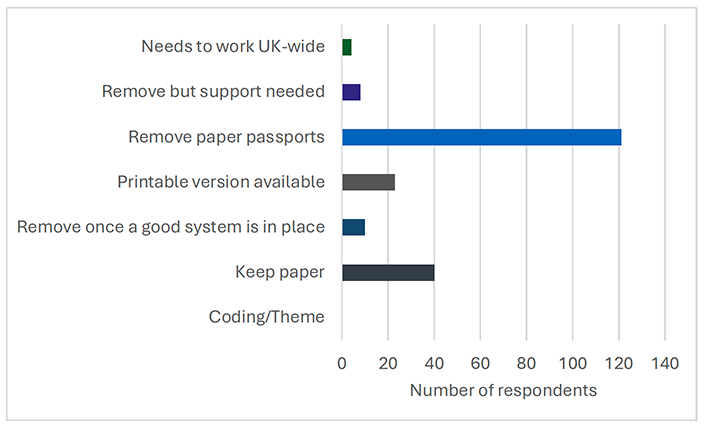
121 respondents who answered this question supported removal of paper passports, however, 23 of those respondents caveated this with the need for a printable option to be available when required. A further 18 respondents were supportive of this proposal noted that while they are supportive, it is essential that there is a good system in place with support available for users less familiar with technology.
“I think the removal of paper passports would be beneficial to the industry as a whole. The cost to the Scottish Government and farmer for printing and posting out the passports is significant.
The industry can access all relevant information pertaining to their stock online and should a paper passport be required they can request one/download and print themselves as a copy.
Currently if a paper passport is found to contain incorrect information then Scot EID is contacted, notified and then another paper passport issued as a replacement. This means animals being sold are delayed until paper passport arrives correctly. However, the instant electronic update would negate any delay and reduce supply chain costs.” [Organisation]
40 of the respondents who answered this question would prefer to keep paper passports and 4 respondents said that it is important that any changes work UK-wide.
Contact
Email: animal.health@gov.scot
There is a problem
Thanks for your feedback